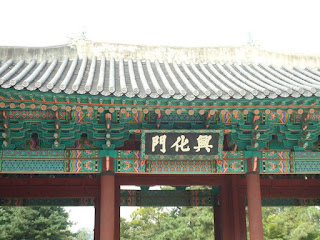Palace of Joy and Light
The construction of Gyeonghuigung Palace commenced in 1617, during the reign of Gwanghaegun, the fifteenth king of Joseon, and was completed in 1620. It was originally called Gyeongdeok but was later renamed Gyeonghui because Gyeongdeok was the posthumous epithet of Wonjong, who was named king after his death. Since the palace was located in the western part of the capital, it was also called Seogwol(”western palace”) in contrast to Donggwol(”eastern palace”), which refered collectively to both Changdeokgung and Changgyeonggung palaces.
The layout of Gyeonghuigung Palace is very unique in that it reflects the lay of the land. Gwanghaegun intended the construction of the new palace to proceed quickly. He delimited the site along an east-west axis with its official and living quarters laid side-by-side instead of the former standing in front of the latter. The painting Seogwoldoan from the latter half of the Joseon dynasty shows some 190 buildings and gates and its main gate, Heunghwamun Gate, facing east or the direction of Jongno Avenue, not south as it does today.
During the Japanese occupation, many palace bulidings were demolished to make space for Gyeongseong Middle School. The palace site was reduced to about half of its original size, and it lost much of its majesty and status. Excavations have recently been done on the site, and three of its buildings have been restored: Jajeongjeon, Taeryeongjeon, and the main hall Sungjeongjeon.
World Tour Guide YouTube
World Tour Guide YouTube
People of Gyeonghuigung Palace
Ten kings lived at Gyeonghuigung Palace, from Injo(16th king) to Cheoljong(25th), Yeongjo(21th) stayed here longer than any other. The palace was bulit to fulfill a prophecy that the site would produce kings, and its saw the birth of Sukjong(19th). He lived 13 years at Gyeonghuigung Palace and died at the Yungbokjeon building here. Crown Prince Sohyeon's coming-of-age ceremony was held at the Gyeonghyeondang building in 1625. Gyeongjong(20th) and Jeongjo(22nd) were enthroned, and Sukjong and Heonjong(24th) had their weddings, and Sukjong, Yeongjo, and Sunjo(23rd) died here.
The heyday of Gyeonghuigung Palace was from the reign of Sukjong to the crowning of Jeongjo. The kings, queens, concubines, and other menbers of the royal family lived their daliy lives here. Residents included Queen Inhyeon(wife of Sukjong), the royal concubine(huibin) Jang(wife of Sukjong and mother of Gyeongjong), and Lady Hyegyeong(wife of Crown Prince Sado and mother of Jeongjo).
Main Place
Heunghwamun
Heunghwamun refers to the front gate of Gyeonghuigung Palace. In 1932, the Japanese removed this gate from its original site in order to use it as the front gate for Bangmunsa, a shrine established to honor Ito Hirobumi, the first Resident-General of Joseon during the Japanese occupation. Heunghwamun was finally moved to this site in 1988.
Sungjeongjeon
It is the main hall of Gyeonghuigung Palace, which was constructed in 1618. Here kings met with their subjects in the morning and arranged offical ceremonies, such as royal feast for foreign diplomats. Gyeongjong(the 20th king), Jeongjo(the 22nd king) and Heonjong(the 24th king) all held their inauguration ceremonies in here.
Jajeongjeon
It contains the king's private living room. The kings held meetings with their subjects and supervised academic competitions here. The Imperial Japan demolished the place and the municipal government of Seoul discovered and verified the area. The current building was restored according to the <Seogwoldoan(sketches for the western palaces)>
Taeryeongjeon
Originally, there was no designated use for this structure. But in 1744, the 20th year of King Yeongjo's rule, a renovation was undertaken and the king's portrait was given a special place of its own.




댓글
댓글 쓰기